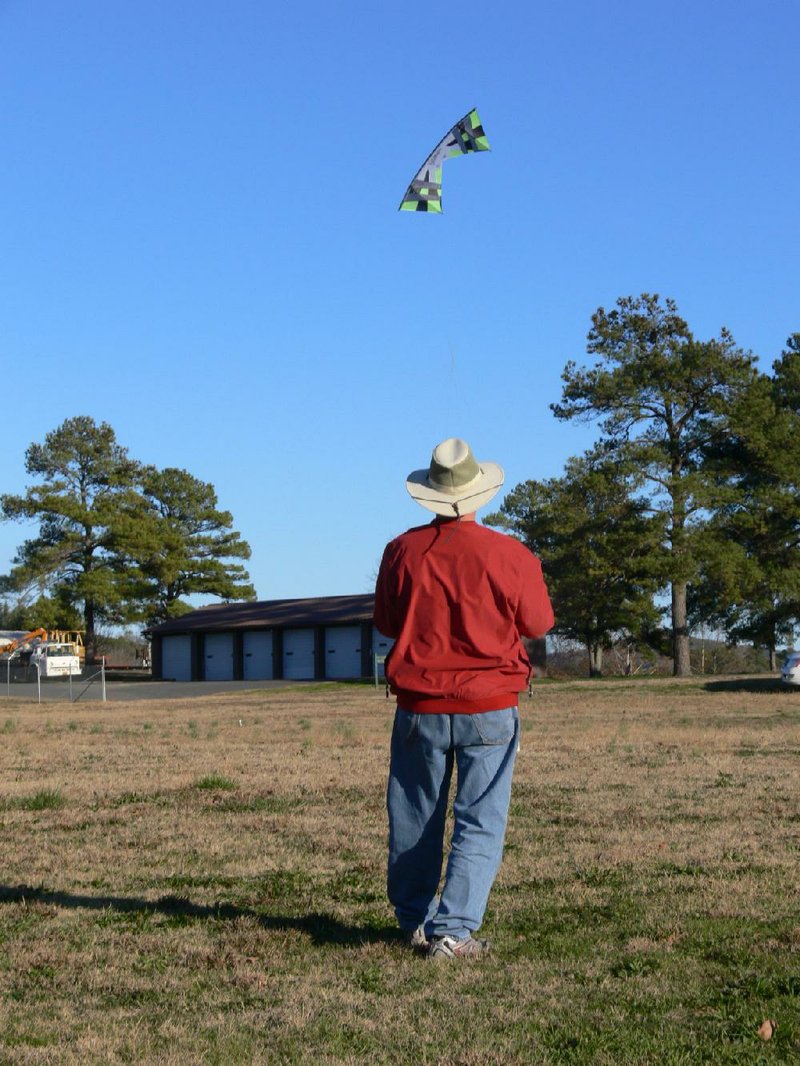LITTLE ROCK — Remember the childhood joy of flying homemade kites?
All you needed was yesterday’s newspaper, a couple of flat sticks, glue, a ball of string and a few strips of cloth purloined from Mama’s rag box.
Thirty, 40, 50 or more years later, that joy can still found, but the kites are better: They’re made with ripstop polyester, polyethylene and other space-age materials.
Modern kites are capable of complicated aerobatic maneuvers, whereas the goals with the homemade kites of yesteryear were:
Get it in the air.
Keep it in the air.
See how high it would go before the string broke.
My interest in flying kites was piqued recently when I happened upon a lone man flying a kite beside Lake Hamilton in Hot Springs. He didn’t just fly the kite, he made it do amazing things - loops, spins, twirls, figure eights.
It would dart across the sky at top speed, then stop on a dime.
He would take it high in the air and drive it straight downward only to stop it a couple of feet before it crashed into the ground.
The wizard in the wind was Robert Lassonde, a retired physician who hails originally from Montreal. After retiring from Methodist Hospital of Jonesboro, where he was head of urology services, he settled in Hot Springs.
He took up kites, more specifically sport kites, in retirement.
He pursues kite-flying year round and often spends part of the winter on South Padre Island in Texas, where there are a lot of sport kiters.
This winter he and his wife vacationed in France, and he took his kites to test the winds along the Mediterranean.
TETHERED WINGS
Sport kites are one of several categories of kite flying (others include advertising kites, art kites, indoor kites, miniatures, fishing kites, electricity-generating kites). Flying sport kites is pursued with two types of kites, dual-line and quad-line (also called “multiline”).
Dual-line sport kites are delta shaped. Quad-line kites are much wider than they are tall, with a straight upper edge; the bottom has two points, much like a bow tie. They don’t use tails for stabilization, but sometimes streamers are added for color and effect.
The term “sport kite” has been adopted by the promoters who developed competitive kiting.
Each of the two styles of kite comes in a wide variety of models, each for specific conditions.
For example, different kites are made for different intensities of wind. Low wind kites are very light; fabric weight and ruggedness of kite construction increase in models intended for flying into more intense wind. Kites for high wind velocity (20 to 30 mph) might have mesh panels in the sail to allow air to pass through, stabilizing the kite and allowing for more control.
Some kites are so light that they can be flown indoors by briskly walking backward.
While materials vary from model to model, most sails are made of polyester or nylon, with bars and struts of graphite and the line made of braided polyethylene, which stays slippery even when wrapped many times.
You need slippery line because many maneuvers, such as spins, twist the lines around each other and then untwist them.
Prices of these kites range from $50 for “starter” kites intended for beginners to $500 for very specific kites for specific conditions; $150 to $250 are typical prices on the kites used by experienced kiters.
As with any hobby, you can invest as little or as much time and money as you desire.
Lassonde showed me several kites of the dualand quad-line types. He explained that he keeps several with him when he goes out to practice, and if the force of the wind changes, instead of waiting for it to die down or pick back up, he simply switches kites. He doesn’t mess around with struggling to keep a heavy kite aloft in a gentle breeze, and he doesn’t struggle to control a low-wind kite in strong gusts.
He also carries a spare parts kit with extra spars, struts, and spools of different lengths and tensile strength of line.
Modern kites have a vast range of aerobatic potential,which invariably leads to the challenge, “Bet you can’t make your kite do this!” Hence kite competitions.
COMPETITIVE AIR
Many of these competitions are sponsored by the American Kite fliers Association (aka.kite.org).
Kite competitions are somewhat like figure skating; that is, each competitor is judged on his ability to make the kite trace required geometric designs in the air (squares, octagons, etc.), as well as freestyle stunts. There are individual and team divisions.
Typically, two or four people make up a team, but there could be as many as eight. In team competitions, all of a team’s kites are in the air at once performing synchronized maneuvers.
The association deals with all aspects of kites and sponsors competitions of not only flying skills but also design and construction. At the 2011 nationals in Wildwood, N.J., there were 13 kite-maker categories (kitebuilder.com).
Divisions include size, with contests for kites as small as butterflies and as large as buses; styles - flat, bowed or soft and flexible; and multiple piece, called trains - for example, a dragon with a head and 20 body pieces all connected and flown with a single line.
Kite flying is an activity that offers something for everyone: Energetic people can fly kites; tinkerers can build them; and those inclined to laze about can lie back and enjoy the view.
ActiveStyle, Pages 23 on 04/02/2012
